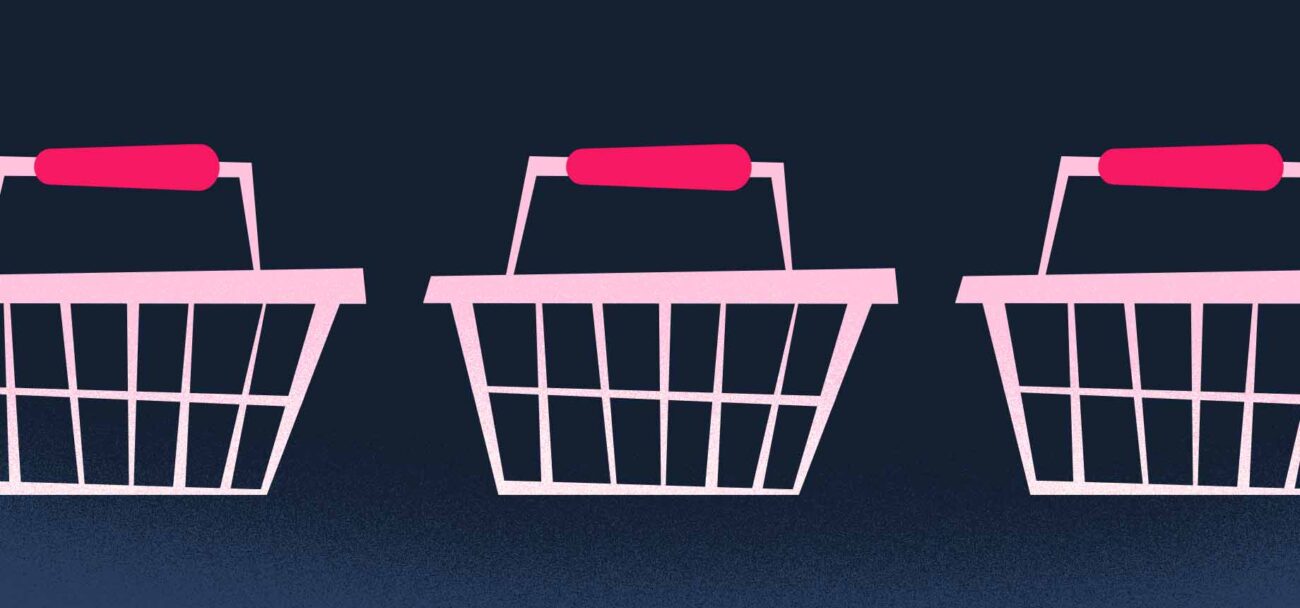
Digital commerce has been the #1 growth driver globally and locally in the US, providing a profitable path for CPG brands, especially within the beauty, personal, household, health and baby care sectors.
Unsurprisingly, COVID-19’s impact on retail has accelerated this omnichannel growth. According to Statista, the health & beauty industry’s ecommerce sales grew by 38% Year-over-Year (YoY) in 2020. Similarly, the ecommerce channel for household and pet care reached a 20% share of revenue.
The majority of that growth has been powered by a shift towards direct-to-consumer (DTC) operations, mainly due to two reasons:
- The fall of physical retail. Brick-and-mortar stores are undergoing a transformation due to new safety requirements, experiential merchandising, in-store fulfillment expansion and services and, as a result, shelf space is shrinking. In addition, more profitable private and exclusive brand competitors are encroaching on the remaining planogram real estate. All these incremental investments mean virtually every retailer has slowed or completely stopped new store openings, which had historically been the growth anchor for large brands in traditional retail.
- The rise of online marketplaces. Online marketplaces are a low barrier to entry for brands to pursue a DTC model, despite them not translating immediately to sales and market share. To compensate for physical stores suffering huge hits, integrating into existing online marketplaces was a good method of securing additional revenue.
Before COVID-19, more than 44% of major CPG companies already had or were planning to launch their own DTC business models in-market. But now, more than ever, for long-term leadership advantage, brands must develop their own DTC capabilities in order to:
- Launch and test product and commercial innovation;
- Own and nurture direct relationships with consumers;
- Measure, monitor and reward loyalty via programming;
- Capture and leverage first-party data appropriately;
- Develop new revenue streams;
- Insure themselves from the potential risks associated with digital retail transformation.
But, for consumer brands vying for attention and market share in an increasingly fragmented category, launching DTC cannot be merely selling the traditional portfolio online. It involves defining and activating a winning value proposition that is relevant to the brand, solves an actual consumer need and delivers an advantage over the status quo.

The DTC Value Formula for beauty and healthcare brands
As a thought provoker for brands looking to improve their current DTC propositions, and for those looking to get started, the DTC Value Formula below offers a great framework to follow. It breaks down the formula into its five factors (i.e. Expertise, Products & Services, Convenience, Price & Promotion, Benefits) and then spotlights some leaders winning across those factors for the beauty, household & pet care, OTC & health care and baby care industries, respectively.
1. Expertise
When it comes to expertise, brands may look to differentiate and outperform the status quo with educational content, in-depth customer reviews and superior customer and/or consultative services.
Here are some great examples in this department:
- Like many subject matter experts, Glossier does not just offer rich educational content, but provides a skincare quiz to better personalize its skincare and product recommendations.
- Madison Reed helps shoppers find the perfect hair color shade through its questionnaire, but then allows them to see themselves with the new hair color using a “try on live” camera feature. If shoppers still aren’t won over, Madison Reed has an “Ask a Colorist” chat functionality to provide expert assistance.
- As an indisputable leader and expert in laundry care, Tide has launched a premium innovation, leveraging its equity, education and enhanced content, to promote its brand toilet paper. Tide uses simple, yet powerful video content on its site to demonstrate the superior strength of its bamboo toilet tissue vs. those of leading competitors.
- Care/of offers supplements that are personalized based on a quiz-based health assessment.
- Rootine offers personalized vitamins and supplements, based on submitted DNA, blood and lifestyle data. Consumers are increasingly researching the components of health care products for allergens, vegan preferences and the use of certain chemicals or ingredients, not to mention side effects, all of which should be easily accessible on the brand’s website.
- Colugo offers a best-in-class customer experience on-site with engaging product content and customer testimonials.
- As an indisputable leader and expert in baby care, Pampers has extended its equity in diapers and wipes to protection and comfort with lumi, its comprehensive baby monitor system.

2. Products & Services
CPG companies may look to provide exclusive brands, products, packs, services and early access to their DTC platforms that are not available in other retail channels.
This way, shoppers are enticed to buy online, a result that the brands below can attest to:
- Skinsei differentiates its skincare quiz and follow-up recommendations by framing the product recommendation as a personalized and purchasable kit unique to the shopper.
- Pinrose understands the challenges of buying perfume online and offers special discovery sampler sets to help shoppers try multiple fragrances before they commit to making a purchase.
- The Honest Company offers numerous products through physical retailers, but offers a much more extensive, exclusive assortment on its DTC site. The company leverages the site as a go-to-market model and incubator for new products and lines before launching nationally through retail.
- As an up-and-coming brand launched through investment initiated from the television series Shark Tank, Blueland leverages DTC to access the broader consumer base with its eco-friendly cleaning product proposition. By leveraging digital to market-test new products, any brand can aspire to enter the physical store shelf once DTC proves the specific SKU’s acceptance.
- Smile Direct Club recognized the significant investment and complexity associated with braces and aligners and provided direct, more affordable access to custom aligners.
- Pillpack by Amazon Pharmacy goes beyond prescriptions and combines them into convenient personalized packs, customized with date, time and usage directions. This is helpful when consumers are in need of more than a single product.
- Ergobaby recently differentiated its high-quality products from its competitors with a strategic product line partnership with Harry Potter.
- While its premium bassinets and seats are available in physical retail too, 4moms offers a full array of spare parts for sale on its DTC site, helping shoppers protect their investments over time.

3. Convenience
Brands can make it easier and quicker for consumers to access their goods and services by offering faster delivery options, subscription services, ease-of-ordering, payment options and more.
The following brands are tailoring shopping experiences by putting convenience front and center:
- Flamingo, a women’s beauty and personal grooming brand launched by Harry’s has successfully taken on the national brand category leaders with its cost-effective and convenient DTC subscription plans.
- VERSED also tackles the convenience of payment through its partnership with Afterpay, an installment payment capability allowing shoppers to pay in smaller increments over time (i.e. Buy Now Pay Later). Most brands tend to offer free shipping and free 2-day shipping mirroring Amazon Prime if an order crosses a value threshold.
- Hearo Club offers a convenient hearing aid battery subscription to its customers.
- Three Main also offers an eco-friendly cleaning solution with refillable cleaner bottles and a refill subscription, so that customers never run out of cleaning products. The convenience of automatic, repeat orders from the subscription model is another way to deliver significant convenience.
- NURX and hims / hers are two businesses that give customers direct and convenient access to product categories that deserve more privacy and discretion.
- Hubble offers subscription services to shoppers in need of prescription contact lenses. Recurring-use categories and need states lend themselves very well to a direct relationship with the brand, not to mention the convenience of predictable delivery. Subscription services and planned interval delivery can be a huge competitive advantage for brands.
- In addition to making the order and fulfillment process simple and frictionless, UPPAbaby offers shoppers on-demand, live virtual Tune-Up Gear-Up tech team appointments to support shoppers with assembly and the occasional repair. With a near-guaranteed 18-36 month sales cycle, this category offers the best opportunity to generate recurring revenue through subscriptions and cyclical consumer loyalty.

4. Price & Promotion
Price will always be a critical factor in the value formula, but it doesn’t have to be leveraged through straight discounts or mere low prices. Brands have many price and promotional levers at their disposal to sell products, such as: unique pricing by customer type, gifts with purchase, daily deals and free shipping.
Take a look at what brands have been doing in this regard:
- In that regard, Beauty Pie is an exclusive membership club, offering significant discounts on luxury beauty products to members only.
- Proactiv, one of the leading skincare brands, is known to offer multiple gifts with purchases to customers who sign up for acne treatment regimen and product subscription plan. This is also an opportunity to showcase and encourage consumers to trade up to higher value baskets and drive incrementality with a captive audience which is very difficult to do in store.
- To drive engagement and conversion, Cleancult offers a simple, yet effective discount off a customer’s first purchase. Multipacks that deliver supplies for a select period of time allow trade-up of a basket, yet deliver value to the consumer, while helping the brand reduce fulfillment costs.
- Like many DTC brands, Ritual offers a simple, yet effective first-purchase discount to drive engagement and conversion.
- Ora not only offers subscription services but, similar to an Amazon Subscribe & Save, it provides an additional discount when signing up for a subscription.
- Smilo discounts its bottle and feeding items and converts them into gift and occasion-based bundles.
- Primary frames its value proposition around consistently offering children’s apparel basics at everyday low prices with empathy for parents who must constantly repurchase clothing for their growing children.

5. Benefits
There are other perks and benefits that traditional brands and digital-native ones alike can offer to enhance their value propositions. This can include rewards programs, social communities, product guarantees and utility tools and technology.
- Birchbox offers shoppers the benefit of surprise, delight and discovery through its monthly beauty product subscription box services. Benefits can also include donations to special causes and organizations, support of local or underserved workforces and sustainable sourcing practices.
- KOPARI uses organic ingredients in its products sourced from small family farms in the Philippines to support their economy, thus becoming a “brand with a purpose”. By promoting its sourcing principles, the company enables customers to participate in the good they’re doing in the world.
- Stasher is a member of 1% for the Planet, contributing a portion of every reusable household container purchase to supporting environmental initiatives and causes.
- Quip not only offers its electric toothbrushes, but also app technology that tracks and rewards customers with incentives and prizes for optimal dental hygiene and habits. Measuring, monitoring and rewarding loyalty with coupons, offers and messages tailored to the consumer are other ways to deliver value to the consumer.
- SmartyPants vitamins is a partner of Vitamin Angels and donates a one-for-one nutrient grant for every bottle of vitamins and supplements purchased to children in need.
- Warby Parker donates a pair of eyeglasses for every purchased pair, enabling shoppers to be part of their charitable initiatives.
- For instance, Bugaboo offers a compelling 100-day free trial on its top strollers, giving customers the piece of mind that their investment will have a high ROI at home.
- Owlet does not just offer baby monitoring products, but complete solutions with app-based technology that tracks and monitors a baby’s sleep, health and more.
DTC brands are ramping up
The DTC companies featured above are curated examples of in-market category leaders who deliver a superior and differentiated value proposition in at least one-factor or area of the DTC Value Formula. But any brand or retail DTC value proposition can, and should, be broken down, mapped out and assessed across these five value formula factors for maximum success and growth potential.
While no opportunity is a guaranteed success, developing sound DTC value propositions today is a smart move. It will ensure beauty brands can continue to lead in the eye of the consumer and maintain long-term omnichannel presence across traditional and proprietary retail go-to-market models.













